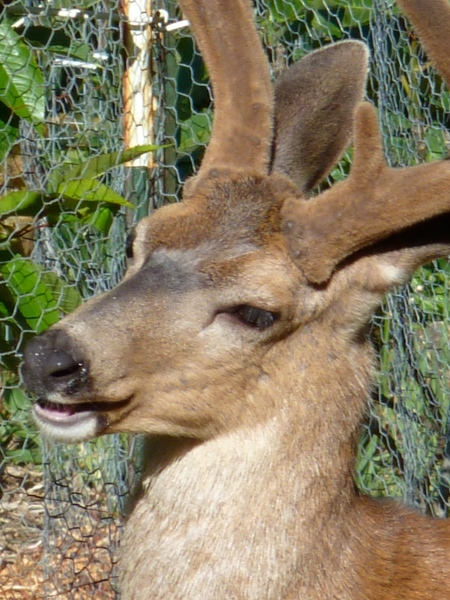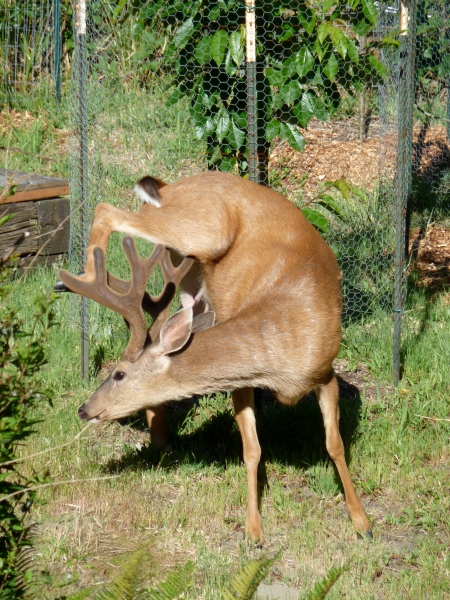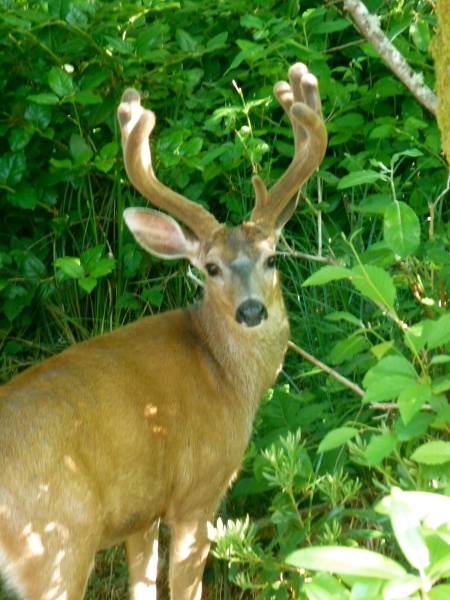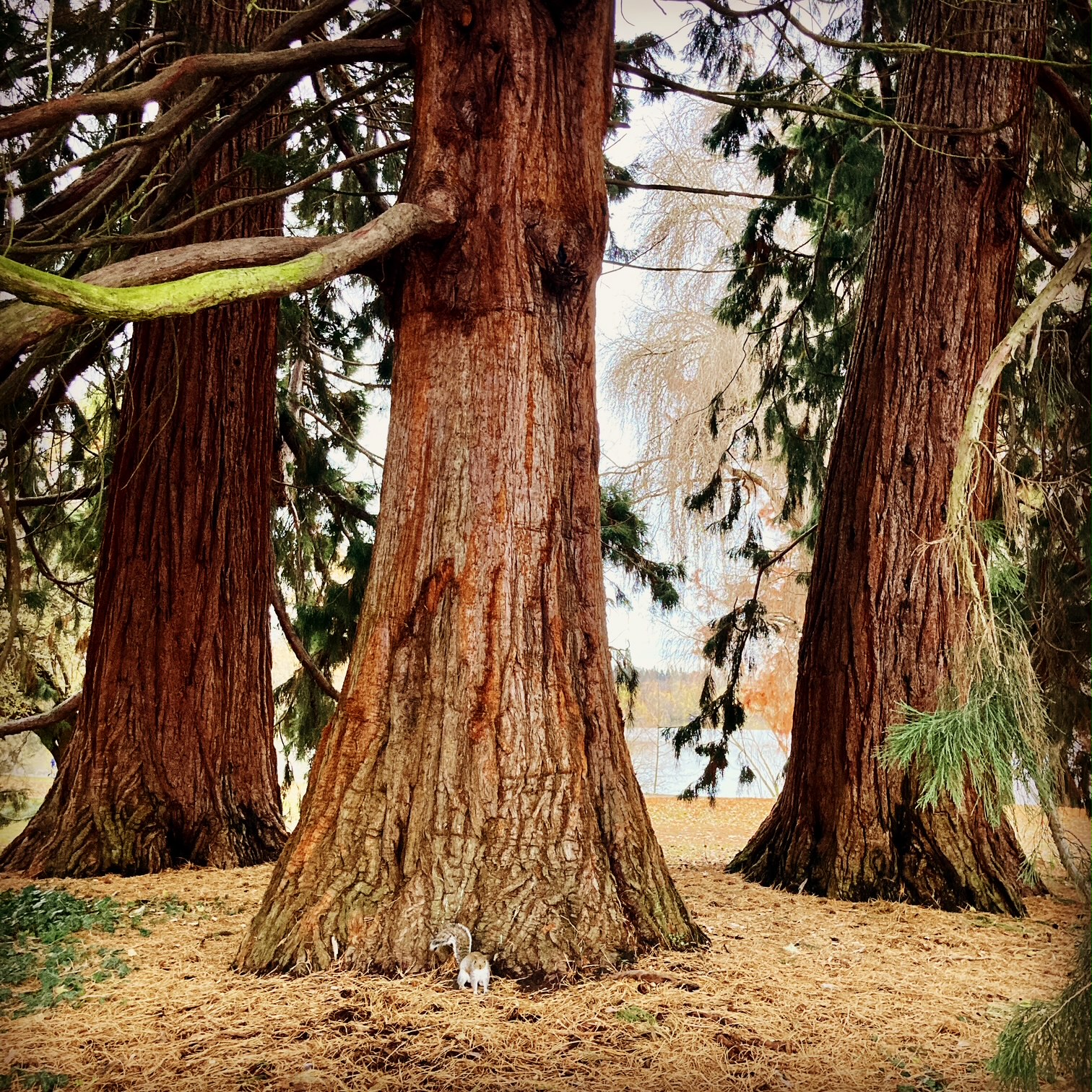After 25 years of life together, Rick still surprises and entertains me with stories I have not yet heard! Early this morning, while soaking in the hot tub, four deer came prancing by. The lovely deer-parade takes place most every morning. We watched as the morning light played off their soft fuzzy ears. The four female deer eating grass jogged Rick’s memory back to another time, to the early 80s, when he was walking through the woods and found a single antler, newly shed from a four-point buck. He had always dreamed of finding a newly shed rack of horns (male deer lose and re-grow their antlers every year!), and there was one at his feet!
Well, the story gets even better. Rick picked up the deer antler and took it home. This part of the story did not surprise me. Our ledges at home are filled with all sorts of Rick-findings: a hornets’ nest (abandoned, of course!), a sun bleached bird skull, feathers shed from birds Rick takes great pride in identifying to anyone who asks about them, agates and moonstones found on our beach, crystals found in a vug he investigated on Denny Mountain, arrowheads and clay babies from the Vaughn Bay Spit, and a fine specimen of Coprolite, also found on the beach, to name a few. By the way, Coprolite, for those of you who don’t know, is fossilized feces. Yeah! Our ledges are great conversation starters.
Back to Rick’s deer antler found in the early 80’s: It had a large mounded base, which was once attached to the buck. Rick took a saw to the base to flatten so, later on, it would stand on a table without wobbling. At this point, he discovered the antler was “fresh”. Antlers receive blood supply and are not at all like, say, human hair. Rick had to first boil the antler. Then he tried to dry the antler in the sun. It still had a smell to it, so he baked it in the oven! Can you imagine? Finally, he drilled holes into it and made it into a cribbage board. Players had to peg up and down the four-point antler to advance in the game. Perhaps Rick then became the sole or first owner of an antler cribbage board! I bet his male friends -because I think this sort of intrigue may fall under the category of a male desire- couldn’t wait to play cribbage with him on the new antler cribbage board!
Rick explained sadly that eventually the cribbage board disappeared. Relieved the cribbage board does not sit on our ledge, I asked, “What happened to the cribbage board, Rick?” “Oh, you know, it disappeared. I think my girlfriend at the time might have gotten rid of it. I can’t remember any more.”

Close up shot of this male’s cute face and velvety horns (cute, even if he dreams of eating all of our apples).
Facts About Deer Antlers
- Whitetail deer antlers begin to grow in the early spring (usually March or April). By late summer a whitetail’s antlers are fully-grown.
- Whitetail deer antlers are one of the fastest growing tissues known to man.
- The growth of a deer’s antlers usually starts to grow out of the deer’s head toward the back of the deer and then changes direction and grows toward the front of the deer’s head.
- Deer antlers have been known to grow as fast as ½ inch per day
- While a whitetail’s antlers are growing they are covered with velvet. Velvet is a living tissue that supplies blood to the antlers allowing them to grow. While a deer’s antlers are covered in velvet they are very sensitive to touch and easily broken.
- Once the deer’s antlers are fully grown they will become hard and the velvet will begin to fall off. Bucks will rub their antlers against trees and saplings to rub off the dead velvet material.
- Bucks don’t grow their fist set of antlers until they are ten months old. Younger deer have smaller antlers because much of their nutrition goes to support their growing body.
- When a mature deer is injured or has poor nutrition it’s antlers will often be smaller then a healthy animal of the same age.
- Pedicles are the part of the buck’s skull where antlers grow from. Buck fawns have pedicles but unless very close to the deer it is hard to distinguish a buck fawn from a buck doe by the pedicles.
- A buck fawn has no antlers and is often referred to as a button buck.
- Many hunters believe that you can tell how old a whitetail deer is by the size of it’s rack. This is not true. A bucks’ antler mass peaks around 5 to 8 years of age, but the biggest determining factor for antler size is genetics and nutrition of the deer. The only reliable way to age a deer is the teeth.









Much a doe about nothing. Love the deer whatever color their tails!
Hey, I’m up late tonight! Good wordplay! Missing you! fg
Fran here wanting to clarify something…the deer that we see out here at the coast in Ocean Shores, WA and that are featured in these photographs are blacktail deer. The blacktail deer are the ones that come prancing by whenever we are in the hot tub in the early mornings. Rick’s story, on the other hand, took place in Oregon and he most likely picked up the antler of a whitetail deer. In my blog above, the “Facts About Deer Antlers” focuses on the antlers of the whitetail deer, like the one in Rick’s story. I didn’t mean to cause confusion about the two kinds of deer, but my photos are misleading and may lead you to think that our Ocean Shores deer are whitetail when they are actually blacktail deer.
Here is some interesting information one of my readers sent: There are a couple of points in your most recent blog with which I would take gentle issue. First, all deer (whitetail, blacktail, mule) as well as elk and moose shed their antlers every year. Second, I believe you are looking at a blacktail deer, not a whitetail. The greatest distinguishing feature, aside from the color on the top of the tail (a black top, as can be seen in your photos), is that the antlers of a blacktail buck just as the antlers of a mule-deer buck have a v-shape on each side; whereas, a whitetail buck’s antlers on each side have a single main stem from which there are small side branches. (By the way, blacktail and mule deer are “cousins”; hence, they have the same antler configuration.) Circumstantial evidence is that blacktail deer are common in the Western part of the Washington; whereas whitetail deer are typically found in the dryer forests of E. Washington (and mule deer in the more open sage/scrub range of E. Washington.)